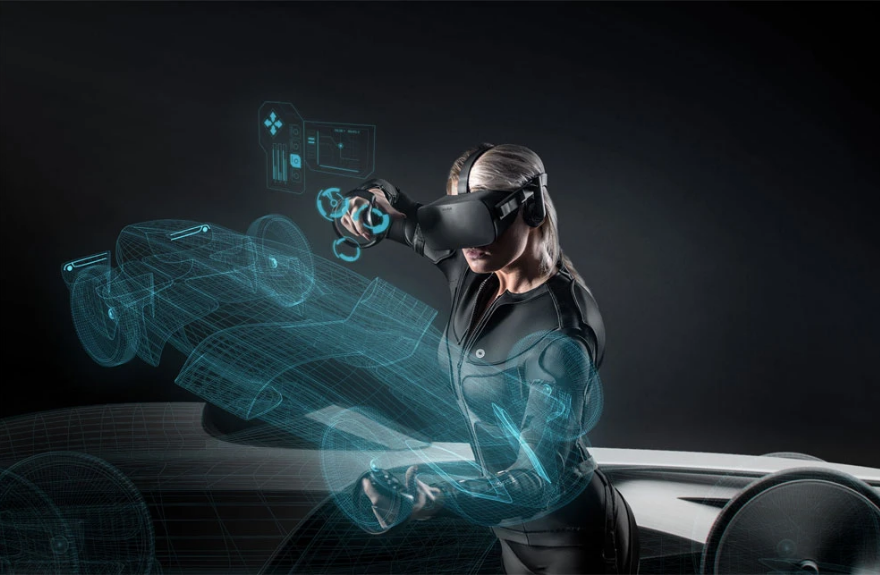
Haptic Feedback Suits - The Future of VR Gaming
Share
 Photo Source: VirtualRealityTimes.com
Photo Source: VirtualRealityTimes.com
Haptic feedback suits provide professional gamers a new level of immersion in VR gaming. VR gaming headsets stimulate our sense of sight and hearing by offering images and sounds of the virtual environment. Haptic feedback suits give gamers a sense of touch in virtual and augmented reality.
Haptic feedback suits use "haptic feedback technology." It was first used in gaming controllers to simulate the kick from firing a gun or the impact of punching an enemy. But that was all it could offer until the full haptic suits were introduced in VR gaming.
A full haptic feedback suit gives its users realistic and immersive sensations relating to a person's sense of touch through applying electrical pulses. These simulations are used to feel virtual objects in the VR/AR environment to improve the virtual experience. By using these haptic feedback suits, gamers can freely interact with the virtual environment in the game.
How Do Haptic Feedback Suits Work?
Haptic feedback is a fast-evolving technology and uses different technologies to deliver feedback vibrations.
Gamepads and controllers, for example, use electric motors. While haptic feedback suits use neuromuscular stimulation.
TESLASUIT
 Photo Source: KGUN9.com
Photo Source: KGUN9.com
Let's take TESLASUIT, for example. TESLASUIT has a sensitization system. It sends a tiny pulse of different amplitude, frequency, and amperage to the suit's electrode. Its technology combines two electrostimulation systems: (1) the Transcutaneous Electrical Nerve Stimulation - TENS, and (2) Electrical Muscle Stimulation - EMS.
These electrostimulation systems stimulate the user's nerve endings to deliver sensations to the user's skin surface. These electro muscle stimulations come as electric pulses, which lead to muscle contractions. Transcutaneous Electrical Nerve Stimulation uses milder penetrative electrical impulses to create sensations.
Combining different variations of these two systems create a simulation of other virtual sensations that enables players to feel the things and events happening in the video game.
bHaptics
 Photo Source: Gadget Flow
Photo Source: Gadget Flow
Another known brand in the industry is bHaptics. The bHaptics has two haptic feedback suits: the TactSuit X40 and TactSuit x16. Both use unique haptic patterns for a fully immersive VR experience. The TactSuit X40 features powerful yet sophisticated haptic feedback delivered by 40 haptic points wrapped around the user's upper body. It's compatible with a range of gaming computers and gaming consoles. The TactSuit X16, on the other hand, is a solid and lightweight haptic feedback suit that packs vibrotactile motors with 16 ERM haptic points.
The TactSuit X40 and the TactSuit x16 haptic suits both feature dual connectivity using cables or Bluetooth. Both gear suits are VR-ready with embedded haptics, have lag-free wireless freedom, and feature detachable and washable mesh lining.
What is the Future of Haptic Feedback Suits
 Photo Source: DigitalTrends.com
Photo Source: DigitalTrends.com
In a sci-film by Steven Spielberg released in 2018 titled "Ready Player One," people in this fictional world enter an immersive VR world called the OASIS. The people could do this using VR goggles, gloves, and full-body suits with feedback to feel the things happening in the OASIS. While everything in the film seems futuristic, it is not far from happening, especially with the evolution of VR gaming headsets and haptic feedback equipment such as bodysuits and gears.
The future of haptics technology will soon combine with machine learning technology to enable personalized and real-time solutions. There will come a time when haptic feedback suits will let you interact with the virtual environment and your co-players' avatars. In fact, researchers from the University of Bristol are trying to develop holographic objects that can be seen and felt using haptic feedback technology.
Haptic feedback suits such as TESLASUIT are being considered to be used in eSports competitions and VR arcade attractions to bring a whole new level of gaming experience. The haptic feedback technology can serve as a tool to motivate gamers to show their full gaming abilities. These haptic feedback suits enhance the player's situational awareness. Players will be able to feel the direction of bullets, the punch of an enemy, the vibration of exploding bombs, and even the footsteps of the enemies.
Haptic devices are now seen by science as a crucial part of the future of wearable devices. Far more than gaming, the haptic feedback technology combined with VR and AR technology can provide healthcare benefits through virtual surgeries and rehabilitation video games for training.
Haptic technology is also used across the industrial sectors of construction, manufacturing, and logistics. For example, in the automotive industry, a car can now alert its driver when a pedestrian is about to cross the street by vibrating its seat.
Last but not least, haptic technology will further be used to improve our way of living. Through the evolution of VR and AR technology, each person will enter metaverses through avatars and interact with their friends and the virtual environment they have chosen or created. As Mark Zuckerberg puts it, metaverse through AR/VR technology will soon outweigh mobile technology.
